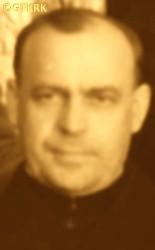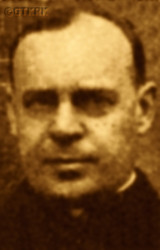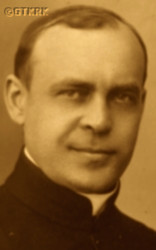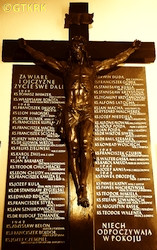Roman Catholic
St Sigismund parish
05-507 Słomczyn
85 Wiślana Str.
Konstancin deanery
Warsaw archdiocese, Poland
full list:
displayClick to display full list

searchClick to search full list by categories
wyświetlKliknij by wyświetlić pełną listę po polsku

szukajKliknij by przeszukać listę wg kategorii po polsku

Martyrology of the clergy — Poland
XX century (1914 – 1989)
personal data
surname
MAKIELA
forename(s)
Theodore Francis (pl. Teodor Franciszek)
function
diocesan priest
creed
Latin (Roman Catholic) Church RCmore on
en.wikipedia.org
[access: 2014.09.21]
diocese / province
Polish Catholic Mission in France
Katowice diocesemore on
en.wikipedia.org
[access: 2013.05.19]
RC Military Ordinariate of Polandmore on
en.wikipedia.org
[access: 2014.12.20]
date and place
of death
02.03.1945

KL Bergen‐Belsenconcentration camp
today: n. Bergen, Celle dist., Lower Saxony state, Germany
more on
en.wikipedia.org
[access: 2022.01.09]
alt. dates and places
of death
01.03.1945
details of death
During World War I ministered as military chaplain of German Imperial Army (in Frankfurt nad Odrą and prob. in Berlin).
After German and Russian invasion of Poland in 09.1939 and start of the World War II, after German invasion of France in 06.1940, arrested by the Germans in eastern France (ministered in France from 03.02.1925) — prob. in 1944, in unknown circumstances.
Held in the internment camp Sonderlager „Feste Goeben” in Wappingen (or in the German political police prison in the same Wappingen).
From there, in 08.1944 at the latest, deported and finally transported to KL Bergen‐Belsen concentration, where perished — prob. from exhaustion, hunger and uncured typhus contracted in the camp — in last month prior to liberation of KL Bergen‐Belsen by Allied troop (on 15.04.1945), one of c. 35,000 that perished in the camp in 01‐04.1945.
prisoner camp's numbers
4104 (SL Feste GoebenClick to display the description)
cause of death
extermination: exhaustion
perpetrators
Germans
sites and events
KL Bergen‐BelsenClick to display the description, SL Feste GoebenClick to display the description, Ribbentrop‐MolotovClick to display the description, Pius XI's encyclicalsClick to display the description
date and place
of birth
08.11.1889Birth certification on:
photos.szukajwarchiwach.gov.pl
[access: 2025.08.19]

Wirektoday: district of Ruda Śląska, Ruda Śląska city pov., Silesia voiv., Poland
more on
en.wikipedia.org
[access: 2022.01.28]
parents
MAKIELA Francis
🞲 ?, ? — 🕆 ?, ?

KITZKA Philomena
🞲 ?, ? — 🕆 ?, ?
presbyter (holy orders)
ordination
21.06.1913

Wrocławtoday: Wrocław city pov., Lower Silesia voiv., Poland
more on
en.wikipedia.org
[access: 2021.04.02]
positions held
from 1938
priest — Hayangetoday: Thionville dist., Moselle reg., Grand Est state, Germany
more on
en.wikipedia.org
[access: 2022.07.16] — i.a. to Polish emigrants
from 1932
priest — Brieytoday: Meurthe‐et‐Moselle dep., Grand Est reg., France
more on
en.wikipedia.org
[access: 2022.06.29] — i.a. to Polish emigrants
from 1929
priest — Caentoday: Caen arr., Calvados dep., Normandie reg., France
more on
en.wikipedia.org
[access: 2022.07.16] — to Polish emigrants; also in Dives–sur–mer, Mondeville and Littry in Calvados dept., Gamaches–en–Vexin, Evreux, Nassandres and Etrepagny in Eure dept., le Petit–Quevilly, le Havre, Rouen and Yvetot in Sekwana Seine–Maritime dept., Flers–de–L’orne and Argentan in Orne dept.
from c. 1925
priest — Le Creusottoday: Autun arr., Saône‐et‐Loire dep., Bourgogne‐Franche‐Comté reg., France
more on
en.wikipedia.org
[access: 2022.07.21] — to Polish emigrants; also in Chalons, Montchanin and Saint Forgeat in Saône–et–Loire dept., Pontarlier and Besançon in Doubs dept., Château–Chinon, Nevers and la Machine in Nièvre dept., Lacanche, Dijon and Beaune in Côte d’Or dept.
1923 – 1924
vicar — Bogucicetoday: district of Katowice, Katowice city pov., Silesia voiv., Poland
more on
en.wikipedia.org
[access: 2021.04.02] ⋄ St Steven RC parish
1920 – 1923
vicar — Wodzisławtoday: Wodzisław Śląski, Wodzisław Śląski urban gm., Wodzisław Śląski pov., Silesia voiv., Poland
more on
en.wikipedia.org
[access: 2021.12.18] ⋄ Assumption of the Blessed Virgin Mary RC parish
1918 – 1920
vicar — Dąbtoday: district of Katowice, Katowice city pov., Silesia voiv., Poland
more on
en.wikipedia.org
[access: 2021.12.18] ⋄ St John and St Paul the Martyrs RC parish ⋄ Mysłowicetoday: Mysłowice city pov., Silesia voiv., Poland
more on
en.wikipedia.org
[access: 2021.04.02] RC deanery
1918 – 1920
prefect — Mysłowicetoday: Mysłowice city pov., Silesia voiv., Poland
more on
en.wikipedia.org
[access: 2021.04.02] ⋄ teachers' school
1917 – 1918
vicar — Kamieniectoday: Zbrosławice gm., Tarnowskie Góry pov., Silesia voiv., Poland
more on
en.wikipedia.org
[access: 2021.03.16] ⋄ Nativity of St John the Baptist RC parish ⋄ Pyskowicetoday: Pyskowice urban gm., Gliwice pov., Silesia voiv., Poland
more on
en.wikipedia.org
[access: 2022.01.28] RC deanery
1915 – 1917
student — Berlintoday: Berlin state, Germany
more on
en.wikipedia.org
[access: 2020.07.31]
1915 – 1917
vicar — Berlintoday: Berlin state, Germany
more on
en.wikipedia.org
[access: 2020.07.31] ⋄ St Peter RC parish
1913 – 1915
vicar — Frankfurt an der Odertoday: Frankfurt am Main urban dist., Brandenburg state, Germany
more on
en.wikipedia.org
[access: 2020.11.13] ⋄ Exaltation of the Holy Cross and Our Lady, Queen of the Holy Rosary RC parish — minister to the Poles
1909 – 1913
student — Wrocławtoday: Wrocław city pov., Lower Silesia voiv., Poland
more on
en.wikipedia.org
[access: 2021.04.02] ⋄ philosophy and theology, Department of Catholic Theology, University of Wrocław [i.e. University of Wrocław (since 1945) / Frederic Wilhelm University of Silesia (1911‐1945) / Royal University i.e. Breslau Academy (1816‐1911)]
others related
in death
BYTOŃSKIClick to display biography Felix, DORSZClick to display biography Bruno, FEDOROWICZClick to display biography Ceslav, GIELECClick to display biography Vladislav Emil, GRZĄDKAClick to display biography Hippolytus, KAŁASClick to display biography Edmund, KRUPIŃSKIClick to display biography Marian Alexander, KRZYSZKOWSKIClick to display biography Ceslav, ROGACZEWSKIClick to display biography Adalbert Theophilus, SIBILSKIClick to display biography Julian, WARTAŁOWICZClick to display biography Alexander (Fr Boleslav)
sites and events
descriptions
KL Bergen‐Belsen: Till 1944 KL Bergen‐Belsen was a prisoner‐of‐war camp, in 1944 was changed into the German Germ. Konzentrationslager (Eng. concentration camp) KL, in 1945 in so‐called „death marches” thousands of prisoners from other concentration camps were transferred, approx. 50,000 of them died in Bergen‐Belsen. When the camp on 15.04.1945 was liberated by the British troops c. 13,000 unburied bodies were found together with c. 60,000 inmates, emaciated, starving, without a food or drink for days, suffering from illness and sickness, mainly typhoid. C. 14,000 of them perished in next two months without regaining strength and health. (more on: pl.wikipedia.orgClick to attempt to display webpage
[access: 2012.11.23], en.wikipedia.orgClick to attempt to display webpage
[access: 2014.03.10])
SL Feste Goeben: Germ. Sonderlager „Feste Goeben” (Eng. Special Camp „Fort Goeben”) established in 09.1943 by the genocidal SS organization, an internment camp, mainly for Russian prisoners of war, Poles and French accused of participating in resistance organizations, in Wappingen (so the Germans called Woippy near Metz in occupied Lorraine). Consisting of two barracks, with c. 10 rooms, it was intended to hold 1,400‐1,600 prisoners. Some of the prisoners worked as slaves in local armaments factories. Abandoned on 31.08.1944, due to the situation on the Western Front. In total, c. 4,336 POWs and prisoners passed through the camp. The German „Erweitertes Polizeigefängnis” (Eng. „Extended Police Prison”) operated next to the camp, managed by the Gestapo German political police. (more on: fr.wikipedia.orgClick to attempt to display webpage
[access: 2023.03.12])
Ribbentrop‐Molotov: Genocidal Russian‐German alliance pact between Russian leader Joseph Stalin and German leader Adolf Hitler signed on 23.08.1939 in Moscow by respective foreign ministers, Mr. Vyacheslav Molotov for Russia and Joachim von Ribbentrop for Germany. The pact sanctioned and was the direct cause of joint Russian and German invasion of Poland and the outbreak of the World War II in 09.1939. In a political sense, the pact was an attempt to restore the status quo ante before 1914, with one exception, namely the „commercial” exchange of the so‐called „Kingdom of Poland”, which in 1914 was part of the Russian Empire, fore Eastern Galicia (today's western Ukraine), in 1914 belonging to the Austro‐Hungarian Empire. Galicia, including Lviv, was to be taken over by the Russians, the „Kingdom of Poland” — under the name of the General Governorate — Germany. The resultant „war was one of the greatest calamities and dramas of humanity in history, for two atheistic and anti‐Christian ideologies — national and international socialism — rejected God and His fifth Decalogue commandment: Thou shall not kill!” (Abp Stanislav Gądecki, 01.09.2019). The decisions taken — backed up by the betrayal of the formal allies of Poland, France and Germany, which on 12.09.1939, at a joint conference in Abbeville, decided not to provide aid to attacked Poland and not to take military action against Germany (a clear breach of treaty obligations with Poland) — were on 28.09.1939 slightly altered and made more precise when a treaty on „German‐Russian boundaries and friendship” was agreed by the same murderous signatories. One of its findings was establishment of spheres of influence in Central and Eastern Europe and in consequence IV partition of Poland. In one of its secret annexes agreed, that: „the Signatories will not tolerate on its respective territories any Polish propaganda that affects the territory of the other Side. On their respective territories they will suppress all such propaganda and inform each other of the measures taken to accomplish it”. The agreements resulted in a series of meeting between two genocidal organization representing both sides — German Gestapo and Russian NKVD when coordination of efforts to exterminate Polish intelligentsia and Polish leading classes (in Germany called «Intelligenzaktion», in Russia took the form of Katyń massacres) where discussed. Resulted in deaths of hundreds of thousands of Polish intelligentsia, including thousands of priests presented here, and tens of millions of ordinary people,. The results of this Russian‐German pact lasted till 1989 and are still in evidence even today. (more on: en.wikipedia.orgClick to attempt to display webpage
[access: 2015.09.30])
Pius XI's encyclicals: Facing the creation of two totalitarian systems in Europe, which seemed to compete with each other, though there were more similarities than contradictions between them, Pope Pius XI issued in 03.1937 (within 5 days) two encyclicals. In the „Mit brennender Sorge” (Eng. „With Burning Concern”) published on 14.03.1938, condemned the national socialism prevailing in Germany. The Pope wrote: „Whoever, following the old Germanic‐pre‐Christian beliefs, puts various impersonal fate in the place of a personal God, denies the wisdom of God and Providence […], whoever exalts earthly values: race or nation, or state, or state system, representatives of state power or other fundamental values of human society, […] and makes them the highest standard of all values, including religious ones, and idolizes them, this one […] is far from true faith in God and from a worldview corresponding to such faith”. On 19.03.1937, published „Divini Redemptoris” (Eng. „Divine Redeemer”), in which criticized Russian communism, dialectical materialism and the class struggle theory. The Pope wrote: „Communism deprives man of freedom, and therefore the spiritual basis of all life norms. It deprives the human person of all his dignity and any moral support with which he could resist the onslaught of blind passions […] This is the new gospel that Bolshevik and godless communism preaches as a message of salvation and redemption of humanity”… Pius XI demanded that the established human law be subjected to the natural law of God , recommended the implementation of the ideal of a Christian state and society, and called on Catholics to resist. Two years later, National Socialist Germany and Communist Russia came together and started World War II. (more on: www.vatican.vaClick to attempt to display webpage
[access: 2023.05.28], www.vatican.vaClick to attempt to display webpage
[access: 2023.05.28])
sources
personal:
www.encyklo.plClick to attempt to display webpage
[access: 2021.12.19], 90.archidiecezja.katowice.plClick to attempt to display webpage
[access: 2018.09.02], bazhum.muzhp.plClick to attempt to display webpage
[access: 2018.09.02], photos.szukajwarchiwach.gov.plClick to attempt to display webpage
[access: 2025.08.19]
bibliographical:
„International Tracing Service (ITS), Bad Arolsen, GermanyClick to display source page”, Arolsen Archives
original images:
muzeum.rsl.plClick to attempt to display webpage
[access: 2025.01.21]
LETTER to CUSTODIAN/ADMINISTRATOR
If you have an Email client on your communicator/computer — such as Mozilla Thunderbird, Windows Mail or Microsoft Outlook, described at WikipediaPatrz:
en.wikipedia.org, among others — try the link below, please:
LETTER to CUSTODIAN/ADMINISTRATORClick and try to call your own Email client
If however you do not run such a client or the above link is not active please send an email to the Custodian/Administrator using your account — in your customary email/correspondence engine — at the following address:

giving the following as the subject:
MARTYROLOGY: MAKIELA Theodore Francis
To return to the biography press below:
 Click to return to biography
Click to return to biography











